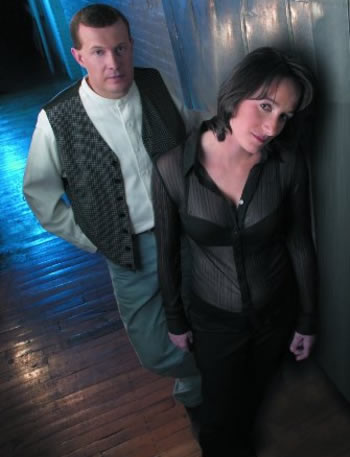
Brian and Michelle Coombes
Image © Larry Dunn 2003
click on image to visit artist's website
Waking In The Blue
Isn't it Pretty to Think So?
album review and artist reflections
(photographically intensive)
reviews, interview and HTML © Russell W. Elliot 2003
images © Larry Dunn, Matthew Yeaton, WITB 2003
as noted and used with permission
click on images to browse artists' website
Formatted for 800 x 600 or larger windows
Last updated: 26 November 2003
Coincident with their first interview in Rock Society, Brian and Michelle Coombes of Waking In The Blue approached Musical Discoveries to ascertain our interest in reviewing their debut album, Isn't It Pretty To Think So?. A short listen to the soundbites available for sampling at their website was enough to convince us that the material needed to be explored further and the artists introduced to our visitors.
The couple's earlier article was built upon Brian's views, with interviewer Martin Hudson drawing from his background with progressive band Tristan Park. Waking In The Blue is a pop-progressive crossover band fronted by the stunning female vocalist, Michelle Coombes. So in contrast to the Rock Society article, this Musical Discoveries interview is more Michelle-centric. Learn about the singer songwriter's background, her contributions to the material and read about the band's influences below. Our review of Isn't It Pretty To Think So? follows the interview.
Interview
Musical Discoveries: So Michelle, tell us about your musical background.
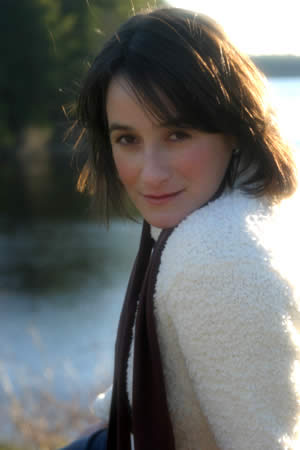 Image © Matthew Yeaton 2003 |
Michelle: I grew up in Nashua, New Hampshire. Growing up, my two older sisters were the musical ones-I was the athlete of the family. I spent most of my time concentrating on my two favorite sports, basketball and softball--playing in summer leagues and on traveling teams, and attending various team camps.
The extent of my childhood singing experience was minimal. There was a brief stint in the school chorus in the fifth grade, the Saturday 4:30 folk mass at church, and, my siblings and I used to do that "Vacation" style singing thing in the station wagon on vacation trips and at family gatherings. We sounded pretty good, too--we had that sisterly harmony vibe-people really enjoyed listening to us!
My start as a singer didn't come until after I graduated from college. I used to catch my oldest sister Karen's gigs every Thursday night at a local bar. One night, after some spurring on by some friends, I got up on stage with Karen and we sang "Closer To Fine" together. We mimicked those Indigo Girls harmonies pretty well and the place went nuts! I think we even did "Secure Yourself" for an encore.
Anyway, that was the start of a really cool musical relationship between my sister and I. We put together a whole set, singing everything from the Indigo Girls and Sheryl Crow to the Stones, the Kinks and the Beatles! Every time Karen had a show, I'd try to make it so we could do our set together. We still sing together when we can. Karen is a professional singer/songwriter. She spends her summers in Provincetown and the rest of the year touring the country performing original music from her two CDs. She has that gutsy, soulful, Melissa Etheridge style. She was voted Best Female Act in Provincetown two years in a row!
And you, Brian?
Brian: Like Michelle, I spent much of my childhood in Hudson, New Hampshire, playing basketball and baseball. I was fairly oblivious to music. But then a friend of mine on a town baseball team introduced me to music, the Moody Blues in particular. He wasn't much of a ball player, but he was a great guitarist.
From there, I absorbed all the music I could. It was the age of the great stadium rock bands: Journey, Foreigner, Styx. Although I enjoyed those bands like everyone else my age at the time, I also found myself gravitating to more "intellectual" bands like Genesis, King Crimson, and Yes. I was always a voracious reader, so I was attracted to the surreal imagery in all those progressive rock classics. Inspired by the prog bands and "poets" like Jim Morrison, I started writing my own lyrics and even put together a band to perform my "songs." It didn't matter that none of us knew how to play. It was more of a performance poetry thing. You should hear those tapes!
As I entered high school I invested in an electric piano, took a few piano lessons, studied some music theory, and set off on a songwriting career. Again, I was focused more on being a poet than a musician, but I think my dedication and vision impressed the top musicians in school, so I was able to surround myself with the best musicians available. A few years later, Tristan Park was born. We played our first gig at a high school dance in December 1986. With our 20-minute rock opera "The Screams for an Absent Dawn" as the centerpiece of our set, we were hardly a success, but we improved rapidly from there. Ten years later, Tristan Park toured Europe for the first time (Michelle and I decided to take the band with us on our honeymoon!). After another tour in 1998, the band decided to call it a day and we all moved on to other projects.
After the 1998 tour, Michelle and I decided to build a recording studio to record our own music projects, although at the time we had only a vague idea of what those projects would be. Today we have a state-of-the-art Pro Tools HD recording system with loads of analog front end and outboard gear.
What artists have been your musical influences and who do you find yourselves listening to all the time?
 Image © Matthew Yeaton 2003 |
Michelle: I grew up around the time when contemporary Christian rock was on the rise, and I was really into Amy Grant, Michael W. Smith, and the Imperials. I practically wore out Amy Grant's "Lead Me On" album. I didn't think the Christian music I was listening to as pretentious or preachy-in fact, I found the lyrics to be real and inspiring. I think the music gave me a great foundation spiritually.
I did not listen solely to Christian rock in those pivotal adolescent years. I was into Peter Gabriel, the Police, Rush, and yes, I had a soft spot for that feel-good 80's pop stuff--Culture Club, Cyndi Lauper, Hall & Oates and Prince all got regular spins on the old turntable.
In college, my musical tastes expanded as my social circles diversified. I discovered Squeeze, Crowded House, The Cure, Elvis Costello, and found out I had a thing for early Billy Joel tunes. Contemporary artists I particularly enjoy are Train, Vertical Horizon, Michelle Branch, Heather Nova, and Cold Play.
Brian: My musical influences range from the previously mentioned progressive rocks acts like Genesis, Yes, and King Crimson to intelligent pop acts like the Beatles, Crowded House, Squeeze, and Joe Jackson. My friends in school always thought my musical tastes were a bit unusual; at least until the first Asia album, Yes's 90125, and the Genesis Mama album came out. Suddenly, my favorite artists were in the mainstream!
Where did you draw the inspiration for the music and lyrics for the first release by Waking In The Blue?
Michelle: When I first met Brian in 1991, he was in a progressive rock band called Tristan Park. I was totally drawn to the music, and particularly the stories the songs told. At the same time, I was also watching my sister perform original music, telling stories of her own. I had kept a pretty in-depth journal all throughout college, so there were lots of song ideas already sitting there waiting for me.
When Tristan Park disbanded in 1998, Brian wanted to try and find a way to keep the music going. His dream of having a home recording studio was right there at his fingertips. We had just built a house in Manchester and Brian went to work assembling a recording studio in our basement, piece by piece. In a few months time, we had a full-fledged working studio up and running! After years in progressive rock circles, Brian wanted to tap into his mainstream pop influences and start a solo project. We decided to try and write a few songs together.
Please elaborate further.
Michelle: While assembling the studio, Brian and I had also purchased a grand piano for the living room. Brian would sit at the piano night after night, writing songs and playing the same progressions over and over again. Whatever I was doing, whether it was folding laundry or working in the kitchen, I found myself humming melodies to Brian's music. Before we knew it, we had a song written, complete with music and melody-all we needed were some lyrics. I went back to my trusty college journal and found some thoughts that I had jotted down after reading A Catcher in the Rye.
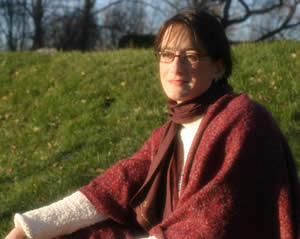 Image © Matthew Yeaton 2003 |
I remember how deeply the book touched me, particularly during one of the final scenes when Holden is sitting in the park watching Phoebe ride on the carousel. He is crying as he watches her, realizing he can't save her from "growing up." She keeps reaching for the golden ring and he's afraid she'll fall off the damn ride, but he doesn't say anything. I found myself bawling during that scene. The thoughts about Holden and Phoebe from my journal seemed to fit perfectly with the song Brian and I had come up with on the piano.
Brian bought me a guitar for Christmas in 1998 and I got to work learning all the basic major, minor and 7th chords. I went to the Online Guitar Archive and learned the chords to some of my favorite songs. Two of the first songs I learned on guitar were "Coming Up Close" by 'Til Tuesday and "After Me" by Marillion. I must have played those songs hundreds of times during those first few weeks.
This is about where "Gum" came along, isn't it? What came next?
Michelle: After I got the strumming thing down, I thought I might try and write my first song. I put a few simple chords together and found that I needed some lyrics to go with the music. I dug into my old college journal and found some lines about chewing gum. "The problem with gum is, it loses flavor. The problem with life is, it's too much like gum." Hence, "Gum" was born. It is true that so many things in life tend to lose their magic. I think part of life is figuring out how to renew that flavor! You can always reach for a new piece of gum, but how do you retain that "sacredness" of love, music, and passion?
After "Gum" came together so quickly, I thought "Hey, this songwriting thing isn't so hard!" I put together a few more chords and wrote most of "Possessions," with Brian helping out on the bridge. The lyrics hit home with me on many fronts. I think it's important to check in with yourself every once in a while and search for the meaning in your life. Sometimes all I can find is just a bunch of "stuff." We spend so much of our time and energy desiring and acquiring "stuff" that we sometimes lose our grasp on happiness. It sounds so easy to be happy-just enjoy life's little things, right? But what if you don't know what those little things are? No, I'm not depressed, and I am thankful for all the wonderful things I have been blessed with, but every once in a while, when I'm by myself, I wonder about what I'm doing on this earth, and if I'm doing the right things. Do I help people enough? Or am I living pretty selfishly, adding more and more "stuff" to my collection?
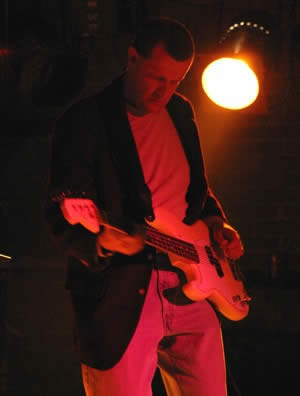 Image © Matthew Yeaton 2003 |
"Not a World Untouched" was a song that Brian wrote on keyboards back in his Tristan Park days. TP never got a chance to record it, so it became part of our little project. The concept of the song title was Brian's and he also had a few lyrics written. When I was trying to put together a melody for the music, I started using a few of the lines Brian wrote. Some of the phrasing wasn't working out, so I wrote a few lines of my own. I like this song a lot, because it brings me back to my days of listening to Christian music. The message is hopeful and uplifting, acknowledging our weaknesses but reminding us that even in the darkest of nights, the sun is still going to rise come morning.
The words to "Where Do We Go?" emerged as my parents were getting divorced after being together for thirty-six years. Brian had written the music and a friend of ours, Rick Carignan, came up with the melody on the verses, but the lyrics were mine. The words came quickly as I watched my parents try and hammer out the details of a messy divorce settlement. The edgy vibe of the song seems to pair up perfectly with the tense, angry lyrics.
Other songs lingered from Brian's Tristan Park. "Window," and "A Single Autumn Day" come to mind as songs of Brian's that for whatever reason never made it on to a Tristan Park CD.
How about some of the other songs, Brian?
Brian: I wrote "Window" when Michelle and I weren't together many years ago. It was inspired by a summer evening that we spent together, looking up and the stars and contemplating the heavens. The lyrics were more of a stream-of-consciousness thing--just trying to paint a picture of a summer night. It's interesting that I was responsible for introducing the two most "spiritual" tracks on the disc, "Not a World Untouched" and "Window." Although Michelle has her background in Christian music, I touched on spiritual themes in Tristan Park over the years in songs like "Once You've Been to Heaven," "Hollow Inside," and "Precious Designs." If I'm not a "religious" person in the traditional sense, I'm a deeply spiritual one.
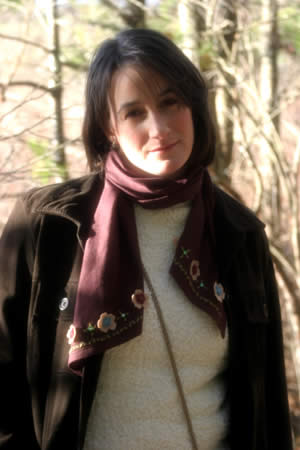 Image © Matthew Yeaton 2003 |
"A Single Autumn Day" was intended for the last Tristan Park disc. The lyric uses the end of the baseball season as a metaphor for the end of a human relationship. Tristan Park had written a song called "The Cruelest Month," which was about the Boston Red Sox and their storied failures in the month of October. "A Single Autumn Day" is about the day after the Red Sox's "tragic fall." Melancholy, but a bit tongue-in-cheek as well.
The album title, Isn't It Pretty to Think So? comes from the last line of Ernest Hemingway's The Sun Also Rises. The line captures the underlying theme of the disc, as does the girl on the cover, who's wearing a blue coat like the one mentioned in "Phoebe." She represents innocence in a cruel and faithless world. It's bleak, but also hopeful.
Where did the band name come from?
Michelle: "Waking in the Blue" comes from a poem by Robert Lowell. We thought it was an evocative title that would make a great band name.
Tell us a little bit about the others that work with you on the album.
Brian: Mike McAdam (guitar) and Jim Turmel (drums) were with me in Tristan Park. It's been great playing with them in a band other than Tristan Park. The dynamic is still the same, but the style of music and the situation is entirely different. Bryan Duff was a friend of Michelle's who made a guest appearance on violin. When we were putting the live band together, we realized that we were going to need a second guitarist to cover all the parts we put on the record. Bryan was a perfect fit for us.
Most people we've talked to have asked us about the special guest appearances by Ian McDonald and Chris Difford. We were tremendously honored to have both of them contribute to our disc. Martin Hudson at the Classic Rock Society in Rotherham arranged the introductions to Ian and Chris. We knew Martin from Tristan Park's touring days.
What were the contributions?
Brian: Ian contributed saxophone, bass clarinet, flute, and acoustic guitar on four tracks. We flew him up from New York to spend a weekend with us in our studio. It was a great experience. Ian's a consummate professional.
Michelle and I flew to England in July 2003 to record Chris at his studio in Sussex. Like Ian, Chris was a professional and was most generous with his time. Chris lends his distinctive backing vocals to "Two," which was one of Mike McAdam's songwriting contributions to the disc.
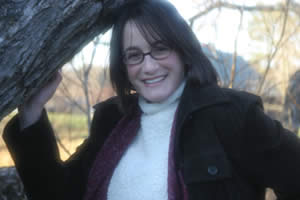 Image © Matthew Yeaton 2003 |
And there were others too, right?
Apart from Ian and Chris, Michelle and I were happy that her sister Karen and my old Tristan Park musical soul mate, Sean Grey, made appearances. We built the studio to make music with our family and friends; we're happy we were able to make that happen.
And how would you characterize your music?
Brian: I think our music could be described as intelligent, introspective pop with some progressive, atmospheric moments.
We hear some latter day 10,000 Maniacs in the sound. What do others say?
Michelle: I've heard people say we sound like The Sundays, Sixpence None the Richer, and the Cranberries.
We found the musical style to develop as the album plays from beginning to end.
Michelle: I find the album to be a great blend of Brian's and my musical tastes and styles. If you run down the song list, the poppy, simple moments are more my contribution, and the ambient, more progressive moments are Brian's. Yet our styles come together nicely in songs like "Why Then?" and "Where Do We Go?"
Brian: The band's style does develop as the disc progresses. We started off with two of the pop tracks, "Gum" and "Two," before moving into more introverted material. I tried to pace the disc from track to track, building atmosphere then breaking it down to go somewhere else. Although the underlying theme throughout the disc is fairly dark, we chose to end with "Not a World Untouched," which is much more hopeful. It was only after the disc was assembled that we realized we'd written a fairly melancholy disc. I'm certainly more introverted than Michelle, but we're actually happy people in real life, so it's interesting that we put together the album that we did. I'm sure the next disc will be more upbeat lyrically.
Tell us about the development of Michelle's vocal style?
Michelle: I have no vocal training. In fact, I would love to have some lessons! I know that I could be stronger and more consistent with some formal training.
My tendency to simply "belt out tunes" comes from my days performing with Karen and doing karaoke with my other sister Deanna. I do a good job imitating other artists, and I'm one of those people who constantly sings along to the radio when in the car, so that is where I pick up some of my vocal style.
Brian: I think Michelle's style is somewhere between her two sisters. Karen has an amazing purity and musicality, while Deanna has a flamboyant diva-like presentation. Happily, Michelle is somewhere between the two.
 Image © Matthew Yeaton 2003 |
And what can you say about your live performances?
Michelle: It will be fun to find out. Our first gigs as Waking in the Blue will happen in November, with our CD Release Party scheduled for December 5th, hosted by a popular Boston adult rock station, The River 92.5. But the band is tight and the material has translated well from the disc. And Brian, Mike, and Jim have played together for so long, playing live for them will be a continuation of what they've always done. I'm looking forward to getting out there.
What plans to you have to tour and promote the new album in the USA and in Europe?
Brian: The band is focusing on local shows for the remainder of 2003. We'll expand our touring reach gradually in 2004, working from Burlington, Vermont to Baltimore, Maryland. Ideally, we'd like to play in a different city each weekend, building the following until we can make the band a full-time commitment. And we're talking seriously about a European tour for the summer of 2004, but we'll need to move on that soon to make it happen. I still have a few booking contacts there, so it's a definite possibility.
How has the internet influenced your musical career?
Brian: The Internet has changed the way the music business promotes new music. Back in 1996, I used email and emailing lists to organize and promote the first Tristan Park tour, but there was little emphasis on web pages back then. Now a web site is essential. We're already selling quite a few discs through the web site.
The Internet levels the playing field a bit for independent musicians. Developing a good web site is relatively inexpensive and gives an independent band the opportunity to look as good online as the major label acts. With a web site the band has a constant marketing presence that never closes. It provides constant and instantaneous information for anyone interested in the band.
Chris Difford and I also used the Internet to transfer files back and forth before and after our recording session in England. That alone reduced weeks of time that we would have spent mailing tapes and discs across the Atlantic.
What are your plans, hopes and dreams for 2004 and beyond?
Michelle: We're looking to play as much as we can in 2004. We'd like to get to Europe sometime soon, hopefully next summer. Beyond that, we're looking forward to writing another disc and starting the recording process again. The studio is such a luxury that we're fortunate to have.
Brian: I'd like to see Waking in the Blue achieve success on our own terms. So many talented artists have taken control of their business destinies these days-Aimee Mann and Grey Eye Glances come immediately to mind. We'll continue to look for new ways to get our music out there. Waking in the Blue is a new project for all of us, so we're all excited to go out and play. We'll see what the future brings.
Album Review
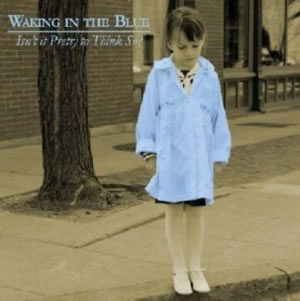 Image © Waking In The Blue 2003 |
The debut album by Waking In The Blue is a ten-track collection of tunes entitled Isn't It Pretty To Think So? (Waking In The Blue (USA) GCD-3101-2, 2003). The album is distributed in North America by Griffin Music, a division of Lakeshore Jazz of Chicago. Produced by Brian Coombes (keyboards, bass, vocals), the album features the vocal work of Michelle Coombes. The lineup for the recording is completed by Bryan Duff (guitars, violin), Mike McAdam (guitars) and Jim Turmel (drums). Contributions from guest artists are mentioned within the interview above.
The album opens with "Gum," an accessible pop-sounding tune that is most reminiscent of latter day 10,000 Maniacs. Michelle's vocals are mixed perfectly across the recording, and her voice works especially well in this opening tune. "Two" builds on this sound with a strong hook and catchy melody. But by "Window" some of the band's progressive influences begin to emerge with vocal harmonies being supported by rich mellotron and well played guitar excursions during the instrumental bridge. The slower bluesy ballad "Phoebe" again highlights Michelle's vocals. Instrumentals build in the bridge--listeners should pay particular attention to the crisp percussion and the orchestral arrangements within the track.
Isn't It Pretty To Think So? develops significantly in a progressive direction in the short track "Where Do We Go?". It begins with a pop-oriented sound but the chord sequences, tempo and instrumental excursions that emerge go otherwise. Interplay between guitars, keys and Michelle's stunning vocal lines is excellent. "Possessions" is another uptempo pop-oriented number with a strong hook and accessible rock instrumentation. We especially enjoyed the uptempo number "Why Then?" with its rich, brass-oriented arrangement. That Michelle's voice soars above the instrumentals--especially in the bridge--demonstrates Brian's mastery in production.
The guitar-laced number "Without Passion" is certain to achieve broad audience appeal not only for the layered vocal passages but for the classic rock instrumental arrangements as well. Great percussion supporting the tempo change in the bridge was especially appreciated. The contrast between the couple's vocal harmonies and Michelle's crystalline lead in the chorus of the mid-tempo "A Single Autumn Day" further illustrates the talent of these fine musicians. There's also a great sax solo by Ian McDonald. The album concludes with the progressive rock piece "Not a World Untouched," which caught our attention from first play. Michelle's powerful vocal is perfectly supported by crisp percussion and delicately arranged instrumentation, again including Ian McDonald's saxophones. We're sure that new listeners will be as keen as we are to hear the band develop the sound further in this direction on their second album.
Clearly the debut album from Waking In The Blue album should be
explored further. Presently it is available from the band directly via their
website and at their upcoming live
performances. With material ranging from pop to progressive, Waking In The Blue is
a band to watch; they have capitalized on Brian's progressive background and Michelle's
pop tendencies to produce excellent material. 
Return to website contents